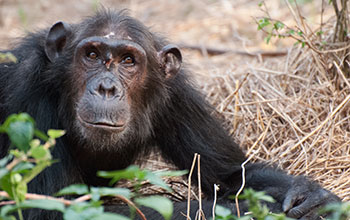Multimedia Gallery
A low-ranking young female chimpanzee
A low-ranking young female chimpanzee in Gombe National Park in Tanzania who was wounded in a fight when she attempted to enter the female social hierarchy. A study by Duke University provides the first detailed look at how social status among wild chimpanzees changes throughout their lifetimes.
More about this image
In the wild, for chimpanzees, social status is more than just a matter of pride. High-ranking chimps of both sexes usually have better access to food and mates, thereby boosting chances of survival for themselves and their offspring. But a study by primatologists at Duke University has found that male and female chimps achieve social status in dramatically different ways.
Male chimpanzees will actively challenge their superiors to win higher rank, but females will accept their position in the social pecking order, waiting until more senior group members die before moving up the ladder. The Duke research provides the first detailed look at how social status among wild chimpanzees changes throughout their lifetimes.
Female chimps tend to be solitary, so opportunities to observe them in the wild to determine each chimp's relative rank is difficult. To compensate, Foerster, along with Anne Pusey, a Duke evolutionary anthropology professor, and colleagues, examined more than 40 years of daily records documenting behaviors of 100 or so wild chimpanzees that reside in Gombe National Park, Tanzania (where Pusey first began working alongside Jane Goodall in 1970).
Chimps use aggressive behavior or make a sound called a "pant-grunt" to signal dominance and submission to each other. The researchers used a new rating system to document these interactions, allowing them to determine the rank orders of male and female chimps and watch how they shifted over time.
They found that, unlike males, whose rank usually peaks when they reach their prime in their early 20s before declining again, female rank gradually increases as they age, and their rank order remains stable throughout their lifetimes. In addition, though males almost always start their adulthoods at the bottom of the pecking order, the female starting rank varies with each individual.
"That seems to be a crucial moment for them, because after they enter the hierarchy at about 12 years of age, they can’t really change anything about their position unless something happens at the top and individuals die," Foerster said.
The team is still investigating how these initial rankings are established, but preliminary evidence indicates that females with mothers in the group seem to have an edge.
The research was funded in part by the National Science Foundation (grants DBI 14-57260, BCS 90-21946, BCS 04-52315, BCS 06-48481, BCS 93-19909, IIS 04-31141, IOS 10-52693 and DGE 11-06401).
To learn more about this research, see the Duke news story Female chimpanzees don’t fight for 'queen bee' status. (Date image taken: 2011; date originally posted to NSF Multimedia Gallery: March 1, 2017)
Credit: Ian C. Gilby
See other images like this on your iPhone or iPad download NSF Science Zone on the Apple App Store.
Images and other media in the National Science Foundation Multimedia Gallery are available for use in print and electronic material by NSF employees, members of the media, university staff, teachers and the general public. All media in the gallery are intended for personal, educational and nonprofit/non-commercial use only.
Images credited to the National Science Foundation, a federal agency, are in the public domain. The images were created by employees of the United States Government as part of their official duties or prepared by contractors as "works for hire" for NSF. You may freely use NSF-credited images and, at your discretion, credit NSF with a "Courtesy: National Science Foundation" notation.
Additional information about general usage can be found in Conditions.
Also Available:
Download the high-resolution JPG version of the image. (6.9 MB)
Use your mouse to right-click (Mac users may need to Ctrl-click) the link above and choose the option that will save the file or target to your computer.



